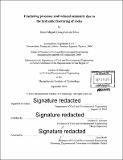Fracturing processes and induced seismicity due to the hydraulic fracturing of rocks
Author(s)
Gonçalves da Silva, Bruno Miguel
DownloadFull printable version (179.7Mb)
Other Contributors
Massachusetts Institute of Technology. Department of Civil and Environmental Engineering.
Advisor
Herbert H. Einstein.
Terms of use
Metadata
Show full item recordAbstract
Hydraulic fracturing is a method used routinely in oil and gas exploitation and in engineered geothermal systems. While used frequently, there are aspects of hydraulic fracturing, such as the propagation of the newly-created fractures and interaction between natural and newly-created fractures, which are not well understood. Since data from field hydraulic stimulations may be difficult to obtain and interpret, laboratory testing and numerical modeling play a major role in understanding the hydraulically fracturing processes. A test setup was developed to simultaneously apply a vertical stress to rock specimens and a hydraulic pressure to pre-cut flaws with various geometries, leading to the initiation and propagation of new cracks. The test setup allowed one to obtain high-resolution and high-speed video images of the hydraulic fracturing processes and to monitor acoustic emissions in Barre granite specimens subjected to constant vertical stresses of 0 or 5 MPa. The imaging data were used to determine the mechanisms of development of the visible fractures produced during the tests. The acoustic emission data were used to estimate the mechanisms responsible for the development of micro-cracks. In order to understand the fracturing behavior of the hydraulically loaded rock specimens, particularly the effect of the ratio between the water pressure applied in the flaws (WP) and the vertical load applied to the specimen (VL), a finite element analysis was performed using the same loading conditions of the experiments. The experiments showed that most visible cracks observed were tensile and that the patterns of the hydraulic fractures produced were strongly dependent on the vertical load applied. They also showed that the water pressure necessary to propagate fractures is dependent on the vertical load and on the flaw geometry. The numerical analysis showed that the ratio WP/VL plays a crucial role in the magnitude and shape of the stress field around a flaw tip, and therefore in the location of tensile and shear fracture initiation. The study of micro-seismic events indicated that tensile and shear micro-cracks frequently developed before visible tensile cracks in the tests with no and 5 MPa of vertical load, respectively. The results presented improve the knowledge of the physical processes involved in the hydraulic fracturing of rocks.
Description
Thesis: Ph. D., Massachusetts Institute of Technology, Department of Civil and Environmental Engineering, 2016. Cataloged from PDF version of thesis. Includes bibliographical references (pages 449-458).
Date issued
2016Department
Massachusetts Institute of Technology. Department of Civil and Environmental EngineeringPublisher
Massachusetts Institute of Technology
Keywords
Civil and Environmental Engineering.